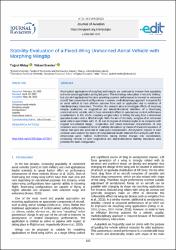| dc.contributor.author | Oktay, Tuğrul | |
| dc.contributor.author | Eraslan, Yüksel | |
| dc.date.accessioned | 2022-12-27T06:29:06Z | |
| dc.date.available | 2022-12-27T06:29:06Z | |
| dc.date.issued | 2022 | en_US |
| dc.identifier.citation | Oktay, T. Eraslan, Y. (2022). Stability Evaluation of a Fixed-Wing Unmanned Aerial Vehicle with Morphing Wingtip. Journal of Aviation, 6 (2), 103-109.
https://doi.org/10.30518/jav.1073417 | en_US |
| dc.identifier.issn | 2587-1676 | |
| dc.identifier.uri | https://doi.org/10.30518/jav.1073417 | |
| dc.identifier.uri | https://dergipark.org.tr/tr/pub/jav/issue/71389/1073417 | |
| dc.identifier.uri | https://hdl.handle.net/20.500.12508/2474 | |
| dc.description.abstract | Aeronautical applications of morphing technologies are continued to increase their popularity and wide spread application during last years. The technology takes place in not only military, but also civil applications that aims providing superior performances to manned or unmanned aircraft than conventional configurations. However, multidisciplinary approach is required for an aerial vehicle to have ultimate outcome from such an application due to existence of interdisciplinary interactions. Therefore, this research aims to investigate effects of morphing wingtip application on longitudinal and lateral-directional stabilities of a fixed-wing unmanned aerial vehicle, which have remarkable effect on autonomous control performance considerations. In this article, morphing wingtip refers to folding the wing from a determined spanwise location with a dihedral angle. With the aim of the study, wingtips of an unmanned aerial vehicle were folded with 15, 30 and 45 degrees of dihedral angles to be compared with original non-dihedral design. Longitudinal and lateral-directional characteristics of new variations were evaluated in terms of stability derivatives by means of linearized equations of motion that were also presented in state-space representation. Aerodynamic impacts of each variation were assessed by means of computational results obtained from analyses with three-dimensional panel method. Furthermore, taking inertial changes into consideration, concluding remarks on both longitudinal and lateral-directional stability derivatives were presented for each configuration. | en_US |
| dc.language.iso | eng | en_US |
| dc.publisher | Edit Publishing | en_US |
| dc.relation.isversionof | 10.30518/jav.1073417 | en_US |
| dc.rights | info:eu-repo/semantics/openAccess | en_US |
| dc.subject | Unmanned aerial vehicle | en_US |
| dc.subject | Morphing wingtip | en_US |
| dc.subject | Aerodynamics | en_US |
| dc.subject | Stability | en_US |
| dc.subject | Autonomous control | en_US |
| dc.title | Stability Evaluation of a Fixed-Wing Unmanned Aerial Vehicle with Morphing Wingtip | en_US |
| dc.type | article | en_US |
| dc.relation.journal | Journal of Aviation | en_US |
| dc.contributor.department | İskenderun Meslek Yüksekokulu -- İnsansız Hava Aracı Teknolojisi ve Operatörlüğü Bölümü | en_US |
| dc.identifier.volume | 6 | en_US |
| dc.identifier.issue | 2 | en_US |
| dc.identifier.startpage | 103 | en_US |
| dc.identifier.endpage | 109 | en_US |
| dc.relation.publicationcategory | Makale - Ulusal Hakemli Dergi - Kurum Öğretim Elemanı | en_US |
| dc.contributor.isteauthor | Eraslan, Yüksel | |
| dc.relation.index | TR-Dizin | en_US |
















